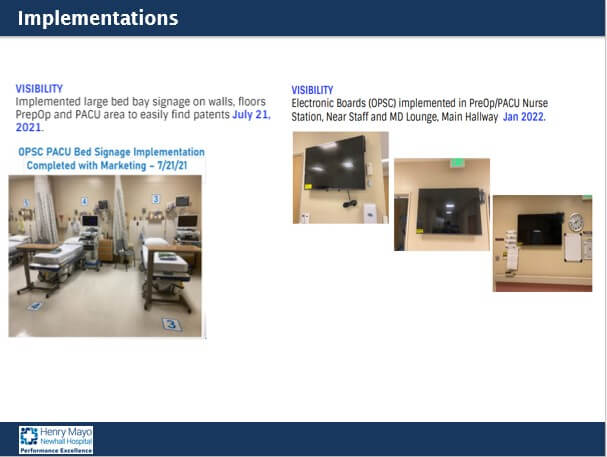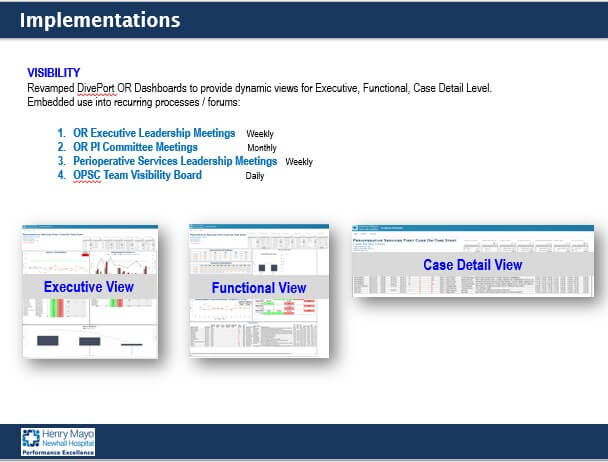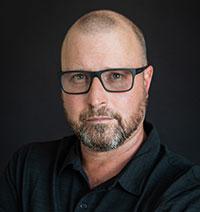Successful Real-World Project Management Examples
Successful real-world project management examples have one thing in common: they support company strategy. Examples show how detailed research, planning, and organization of resources helped real-world project managers achieve a particular aim that moves the organization forward.
Successful project management examples reveal that, in order to reach the final goal, you must have and maintain a big-picture view. Other success factors include involving stakeholders, reviewing multiple frameworks and solutions, and keeping the lines of communication open.
Henry Mayo Newhall Hospital Case Study: Increased Outpatient Surgical Center Performance
Henry Mayo Newhall Hospital is a 357-bed not-for-profit community hospital and trauma center in Santa Clarita, California. Jay Arcilla, Director of the Performance Excellence Office, is charged with studying and adapting the functions and processes to increase the achievement of desired outcomes, better meet patients' needs, and assure quality.
- Challenge: In every hospital, starting the day's first scheduled in-patient or out-patient surgery on time has a knock-on effect on subsequent surgery timelines. Meeting schedules can always be challenging. The pandemic created even more hurdles, from having the right supplies and equipment on hand to keeping up with documentation and ensuring the right personnel are available to cover every patient's needs. Arcilla focused on raising surgery on-time start times to 70 percent.
- Solution: After carefully surveying all the influencing factors, Arcilla put multiple implementations into action. Here are some examples:
- Electronic Signage: Prominently placed within the Outpatient Surgery Center (OPSC) and other relevant locations, the new easy-to-update signs make it easy for staff to find patients. Source: Henry Mayo Newhall Hospital
- Work Sessions: A team work session helps frontline staff analyze the root cause and create a consensus-driven, interdisciplinary team.
- Dynamic Dashboards: These dashboards show executive, functional, and case detail views. The high-visibility visual aids designed and developed by the Interdisciplinary Team represent a process created with the end customer in mind. Source: Henry Mayo Newhall Hospital
- Communication: Disseminating information and encouraging discussion for all stakeholder groups.
- Accountability: The operating room executive leadership created and enforced an Outpatient Surgery Center First Case On-Time Start (OPSC FCOTS) Escalation Plan, holding all staff accountable for showing up to first cases on time.
- Takeaway: In complex, multi-layered project situations, there is often no single silver bullet. Instead, results manifest over time. In this case, within seven months, monthly performance went past the 70 percent target to 89 percent for April 2022.
Behr Process Corporation Case Study: Paving the Way for Road Show Marketing Achievement
Behr is one of the largest purveyors of architectural paint and exterior wood care products in the United States and Canada. Lisa Kudukis, Director of Professional Products and Services for the Behr Process Corporation, oversees promotions, including a major road show.
- Challenge: Kudukis created the BehrPro Experience Tour to connect with U.S. contractors. The annual event employs five tour teams covering 75 markets and 500 Home Depot locations in 34 states. Initially, each manager used different tools and organizational tactics to run their activities. Supervising people and processes and collaborating to maximize efforts was challenging. The Behr marketing team needed a way to operate more efficiently and stay on task.
- Solution: After an exhaustive review, Kudukis chose Smartsheet as the group's project management tool. Everyone on the team now uses a single, custom template. A master dashboard relays information about key initiatives and features a drill-down menu so anyone with access can check on small details.
- Takeaway: For the team, it is a huge time and money saver since anyone can view the project status and provide assistance if necessary. It also helps the team identify new business development opportunities or obstacles to inform future promotions and projects.
Successful Software Project Examples
Software projects involve generating an overall plan, scheduling, allocating resources, executing, tracking, and delivering quality software and apps. These examples show that successful software projects deliver the product with the pre-agreed level of quality within the given time and cost.
Software companies create, change or maintain valuable products. Software project management is one of the most complex and fastest-growing endeavors in business today.
Hyland Software: More Responsive Updates and Website Requests
Jacob Huston-Lowery manages web operations at Hyland Software, a content services platform and developer of Onbase, an enterprise content management (ECM) and process management software suite. Hyland cuts dozens of hours from the website request process while capturing data to drive ongoing improvement for its clients. Clients include insurance, manufacturing, higher education, and finance businesses that provide web-based services to their customers.
- Challenge: Providing efficiency and seamless services is paramount to maintaining Hyland's standards. Service requests from internal staff who noticed system issues, along with those on behalf of customers, created log jams and confusion. When Huston-Lowery came on board, there were five different contact forms, and some requesters were bypassing the process and sending emails.
- Solution: Huston-Lowery turned to Smartsheet to find an easy-to-use solution for the critical challenges his team faced. Using project messaging and alerts within the app helped eliminate email delays. When users complete an online form with an alert for urgent projects, Smartsheet routes website requests to a sheet Huston-Lowery manages. As requests come in, all projects are prioritized, scheduled, and assigned to team members or third-party website management agencies.
- Takeaway: By replacing email trails with built-in alerts and update capabilities, the Smartsheet solution saves communication time and eliminates duplication. The ability to handle requests strategically helps the team implement a support program that runs 24 hours a day, 5 days a week – a process that was impossible before instituting the new project management process.
Examples of Successful IT Projects
Information technology (IT) projects ensure that software, devices, and systems work together to help people get things done.
Managing IT projects and creating efficient IT project plans involve all aspects of planning, design, implementation, project management, and training.
Convergint: A Single System of Record Improves Processes and Customer Service
Jenn Hilber is the Business Architect, Operations for Convergint, the largest privately held security integrator in the United States. Convergint has more than 175 locations worldwide, providing a range of services, including installation and management of card readers and cameras, alarm systems, fire systems, building controls, and more.
- Challenge: The company prides itself in creating an outstanding customer experience, but managing all the details seamlessly was difficult. Convergint relied on manual practices and printed playbooks, with no single unified process for most of its activities.
- Solution: Convergint turned to Smartsheet to capture all of its data, best practices, and resources in a single place. As a result, teams can make strategic decisions and act on customer priorities with confidence knowing that they have the most current and accurate information at their fingertips.
- Takeaway: Convergint teams now enjoy better cross-team and global communication, a clearer insight into customers' needs and status, and greater accountability for internal processes. Customers also experience quicker turnaround time for requests.
Exoft: Shifting to Mixed Methodologies Rescue an IT Project Management Client Relationship
Bohuslava Zhyvko is Head of Marketing for Exoft, a software development services company located in Lviv, Ukraine. Exoft builds robust web and mobile solutions with a focus on increasing clients' efficiency and solving technology challenges.
- Challenge: Zhyvko began a new assignment with an IT client previously managed by another project manager. Zhyvko learned the IT client didn't want to hear about Agile methodology or process at Exoft; he simply wanted to complete his project ASAP.
- Solution: Zhyvko immediately requested a kick-off conference call. During the call, she discussed the goal and purpose of the project and clarified the main issues that were creating stress points. After the call, Zhyvko gathered the team and included Exoft's CTO. The weaknesses of the client's planning and reporting systems became apparent, and Zhyvko offered the solution: Agile, after all. The team used a mix of Scrum and Kanban to replace Waterfall, which wasn't the right approach for the nature and goals of the project. They divided the project's scope into milestones and sprints, then switched the look of the workboard in Jira. Zhyvko supplied the client with a process improvement proposal and SOW with all the features he wanted. Zhyvko explained how the project's formal change request procedure worked and shared the documentation, so the client could clearly understand the development process, which they accepted and signed.
- Takeaway: After three months, when two milestones were closed, the client was pleased with the deliveries and the Scrum working process. The project concluded after milestone 11 with a client who was pleased with the outcome. His startup is growing extremely fast, and the company and Zhyvko have an excellent relationship. Solid planning, reporting, and communication can turn around even the most complex project management challenge.
Examples of Successful Completed Business Projects
Efficiently reaching project objectives is a key element of project management success. Efficiency relates to how the project’s limited resources are managed to meet its goals while building good relationships with internal and external stakeholders.
Whirlpool: Regional Alignment for Smoother Operations
Thiago Zapparoli is a Senior Planning Engineer at Whirlpool Corporation. The global home appliance company relies on regional project managers to manage its extensive portfolio.
- Challenge: When you're responsible for managing a project portfolio of a global home appliance company — including approximately 400 individual projects across five worldwide regions — you need a comprehensive system to keep everything on track. That's why Zapparoli looked for a way to get project managers, leadership, and other stakeholders on the same page with the laundry and dryer portfolio he manages.
- Solution: Zapparoli knew he needed an effective and unique system for all project managers to aggregate the 400 projects that covered multiple regions around the globe. At a minimum, the project management system needed to identify responsibilities for each project and task; key performance indicators; and open, completed, and delayed tasks. Smartsheet offered an all-up view of an entire region, providing real-time visibility into the overall project status and numerous tasks. First deployed in Brazil, the holistic tracker transformed how the 10 project managers and cross-functional leaders in that region approach their daily work and stay in sync.
- Takeaway: After implementations in Brazil and the United States, Zapparoli’s Smartsheet trackers are used in all three remaining regions and assisted deployment in four other Whirlpool internal organizations. Project managers are engaged because they have control over projects. Cross-functional leaders are satisfied with the visibility, and senior leadership can now see how they can help.
Simplus: Improved Sales Process
Katherine Albiston is a Content Manager for Simplus, an Infosys company that provides a strategic, industry-focused digital transformation for customers in the Salesforce ecosystem. She shares how Simplus’ customer Ziehm Imaging needed to improve its sales process to garner maximum efficiency and profits, as well as the company’s solution for them.
- Challenge: Simplus customer Ziehm Imaging, Inc. was using a legacy configure, price, quote (CPQ) system process for defining new products or modifying bundles. As a result, it took up to a week to go to market. A Microsoft Excel-based process further complicated managing market-specific annual pricing updates, which required a manual price override to apply pricing for each segment. The manual work increased errors, eroded margins, and led to customer communications about pricing adjustments – not good for relationships.
- Solution: Simplus simplified Ziehm's bundle configuration process and centralized compatibility management rules. It now uses a lookup-based rules setup for products that enforces business policies in real time as sales reps interact with the CPQ system.
- Takeaway: Streamlining and installing coherent systems decreased Ziehm's quote creation time by 93 percent, troubleshooting time by 87 percent, and the time to add products by approximately 87 percent. The lesson is clear: A holistic approach to process improvement can reap impressive benefits.
designdough: A More Refined Recruitment Process
Molly Govus is the Marketing Manager of designdough, a full-service U.K. design firm. The company tightened its use of project and time management tools to run projects and realized it needed to do the same for managing internal projects.
- Challenge: designdough audited its recruitment process and discovered four key issues: Permanent and temporary staffing ebb and flow was always in flux depending on client project demands. There were no clear start-to-finish timescales, and they lacked transparency with staff regarding project timescales. Staff capacity related to assigned tasks was unclear. Finally, the firm lacked designated client communication points.
- Solution: They started by planning and documenting every resource and task using a project management tool that provided visibility for all team members. They wanted to clarify the audit's issues and organize information and project processes around recruiting by implementing clearly delineated stages (Administration, Interview, Offer, Induction, and Confirmation). Now, they set start dates for each step and complete tasks before moving to the next stage. Additionally, they add relevant tags, such as meeting, to tasks so they can easily identify who is assigned the task assignment and dates attached to every job.
- Takeaway: Thanks to a straightforward process and an efficient project management tool, the team met its recruitment project goals. They now encounter fewer bottlenecks and have an easier recruitment process that has improved staff and client satisfaction and relationships.
What Is the Measure of Project Success?
The measure of project success is meeting the initial criteria established by the internal or external client and the project team. Teams use these specs, milestones, and deliverables to evaluate a project after it closes.
“Project managers are experts at helping people define problems,” notes J. Scott, CEO of 120VC and author of The Irreverent Guide to Project Management. “Data drives and measures success to control the outcome and move the project forward as aggressively as possible, leaving no time or money on the table.”
In its 2020 report, “Ahead of the Curve: Forging a Future Focused Culture,” the Project Management Institute (PMI) found that organizations that operated from mature ROI capabilities geared toward meeting strategic goals, working within predetermined budgets, delivered segments and the entire project on time with limited scope creep. High-maturity companies had 50 percent fewer project failures than low-maturity organizations.
A success measurement framework includes:
- Buy-In: Worthy projects and outstanding ideas can fail if critical stakeholders aren't behind the effort. With buy-in, resources will be available, and you can move the project forward.
- Strategic Approach: One of the best ways to guarantee buy-in is to make a business case that shows how the project fits into overall company goals and will positively impact the organization’s future. According to an article on the six questions to ask before starting a big project in the Harvard Business Review, a good distribution of resources is 60 percent in support of the core business, 30 percent in the adjacent business area, and 10 percent unrelated to your core business.
- Meticulous Planning: Completing projects on budget and on schedule relies on thorough advanced planning. Professional planning includes defining the scope and objectives of the project and operating from an understanding of the resource and budget limitations that affect your project.
- Continuous Monitoring: Once the project begins, it's essential to monitor all activities, resources, and expenditures almost constantly. You will likely find that you’ll need to make adjustments to some elements in every project. You will want to monitor the execution of tasks against milestones, keep an eye on quality, track whether you are on schedule, and verify money is spent according to plan.
- Make Relationships a Priority: Stay in touch with clients, vendors, and internal team members to stay informed about project status and build relationships. Once the project concludes, check in with stakeholders to see what worked and what didn't so that you can apply winning strategies and tactics to subsequent projects.
Common Project Management Success Metrics
Metrics for on-target project management track productivity, assess resource utilization, monitor the scope of work changes, and measure quality. Assuring a low number of defects throughout the project and providing a quality deliverable at its end should be a metric for any project.
Examples of crucial project metrics include the following:
- Resource Utilization: This metric assesses how individual team members or the project team spend their time against the total number of hours allocated for the project. Periodically checking time spent on the project can help assess how human energy is being used. For organizations that bill hours, this is an important metric to monitor and review at the end of a project.
- Schedule Variance: This metric helps project managers determine if projects are running according to the planned budget or ahead of it. A negative schedule variance means the project is behind schedule.
- Cost Performance: This metric measures efficiency. Divide the work performed or earned value by how much money it took to accomplish tasks. Accurate budget estimates rely on forecasting cost performance.
- Cost Variance: This metric pinpoints how you are operating within a planned budget. The purpose is to see if you are running below or within budget. If cost variance is negative, the project is over budget. If it’s under budget, that means you are achieving budget and project success.
- Gross Margin: A strategically planned project aims to contribute to the company by increasing profits. The gross margin is the difference between the total income and total project spend. It’s best to establish the gross target margin before a project begins and measure it on an ongoing basis. Achieving or exceeding a gross margin is the primary mark of project management excellence.
With project metrics in place and the right tools to track that data, it is easier to crunch the numbers on previous projects to see what went right and what task ended up causing a significant delay.
What Skills and Tools Support Project Management Success?
You need various tools and skills to guide projects to the desired goal. Soft skills are people skills or emotional intelligence. Hard skills are specific to project managers and can be learned through formal training or on the job.
The exact project management techniques and tools you need depend on your industry, company, and team preferences. The vital foundation for success is to create your project plan and lean into best practices that focus on organization, communication, and team leadership. "There are many methodologies project managers employ," says 120VC’s J. Scott. "Waterfall, Agile, Lean, and more – but the most important skill to have is leadership and a people-centric framework since it is people that get [expletive] done.”
Project management skills and tools to help you meet project management challenges – and win – include the following:
- Soft Skills: Soft skills are interpersonal skills such as communication, flexibility, leadership, teamwork, and time management.
- Hard Skills: Hard skills, also known as technical skills, accrue through on-the-job training or formal education. Hard skills include technical writing, software development, budget management, negotiation skills, project planning, and knowledge of these tools and frameworks:
- Project Management Tools: Tools is another word for software. Purpose-built project management software supports teams in the planning, tracking, and managing of projects to meet stated goals on time and within budget. These also serve as a repository for data that will inform the post-project analysis.
- Project Management Methodologies and Frameworks: The Project Management Body of Knowledge (PMBOK) Guide describes all the PM methodologies and techniques available to manage projects. Project managers choose frameworks such as Critical Chain Project Management, Lean, Scrum, and Waterfall for their projects.
Reasons Projects Fail and How Modern Project Software Supports Success
Projects fail for many reasons. Those include inadequate preparation, poor documentation and tracking, and poor communication. Modern project software can help solve those problems and support success.
"Project management, particularly at the enterprise scale, is about getting to desired outcomes as efficiently as possible under any conditions," says 120VC's Scott. "You must be agile (with a lowercase a) to get things done to reach those outcomes." Modern software is the way forward.
“IT projects have an exceptionally high failure rate of 44 percent,” says Scott. “These projects fail due to a lack of alignment between business and project objectives. As software project failure statistics show, the lack of alignment of projects with the business objectives is why nearly half of the strategic initiatives fail.”
5 Famous Project Management Failures and How They Could Have Been Solved
Project management failures are part of most projects. The key is to learn from past failures and track projects closely to get back on track when things go awry.
1. Citibank Interest Payment Failure
Citibank intended to make a $7.8 million interest payment to creditors of its client Revlon. Instead, the company paid $900 million because of errors due to aging software. Citibank's employees set up a transaction as if they were paying off the entire loan to calculate the interest correctly, then check numerous boxes to deliver the majority of the sum to an internal Citibank account. Three different people signed off on this transaction, most of which wasn't due to creditors until 2023, but the Citibank employees didn’t check all the proper boxes. Creditors kept more than $500 million of the payment. A judge ruled that they didn't have to return the money because he said it was not believable that one of the largest and most sophisticated financial institutions on earth could make such a mistake.
- Takeaway: The big lesson is to modernize your software and user interfaces, so employees can perform their duties in a streamlined, logical fashion. Remember: You might suffer less when you make mistakes if people aren't angry enough to take advantage of those errors.
2. J.C. Penney Rebrand Failure
Ron Johnson, who has a successful branding track record, took over as J.C. Penney's CEO in 2011. Johnson's "cheap chic" rebranding for Target was enormously successful, as was his previous work with Apple to generate its outstanding and consistent brand experience. Defying expectations, Johnson's rebrand for Penney's was a dismal failure. His goal was to revitalize the chain by making "hip" changes. He wanted to shake things up at the company by doing away with sales and coupons, nixing some of the legacy merchandise, and modernizing the store’s physical layout. It failed miserably. Revenues dropped from an already low level, and after 17 months, Johnson was out.
- Takeaway: No matter how cool or innovative a new brand concept seems, robust market research is mandatory. J.C. Penney's poor financial state forced Johnson to act too quickly. As such, he failed to align the likes and dislikes of J.C. Penney's loyal existing customer base with new tactics. That's not to say the change involved in rebranding has to be totally at the mercy of your customers' extant preferences. When a brand has long-standing customer favorite factors such as discounts and coupons, it may be best to roll out changes slowly rather than all at once to acclimate existing customers to a new direction.
3. McDonald's Arch Deluxe Burger
The fast food giant put an unprecedented $150 million into advertising for the Arch Deluxe Burger, only to discover its customers weren't interested in the sophisticated, ”gourmet” menu option. Mistakes include marketing to a new, disinterested Gen X demographic while neglecting the brand's core audience, overpricing the burger to cover the additional costs it took to create, and franchisee disinterest.
- Takeaway: The message is to never ignore your buying base and pick the right metrics when you start and run a project. If McDonald's had a more accurate picture of what its customers wanted and conducted more testing with existing customers, the company could have saved its money, resources, and reputation.
4. Dyson Electric Car
James Dyson spent a small fortune – more than $600 million – on a seven-seat electric car with a 600-mile range. Then Dyson scrapped it before the prototype ever hit the road. Electric vehicles are costly, and the battery, battery management, electronics, and cooling system are much more expensive than an internal combustion engine. Tesla — hailed as a success by many — has burned through $19 billion of investor cash and is still not profitable. It turned out that each Dyson would have had to fetch roughly $183 million to break even.
- Takeaway: The British government wants to ban sales of all fossil-fuel cars by 2035, so Dyson shifted its focus. The company continues to work on solid-state battery manufacturing. Solid-state batteries are the key to making electric vehicles functional and desirable. Highly efficient, as well as smaller and lighter than ion batteries, solid-state batteries generate less heat and are easier to recycle. Dyson says he could return to electric vehicle production when commercial and financial circumstances change.
5. Coca-Cola and New Coke
The company tested New Coke with 200,000 consumers. Most people who tried it preferred New Coke over the traditional product. Based on that information, Coca-Cola launched New Coke in 1985. But the new product did not sell, and product loyalty and people’s old-fashioned habits got in the way. The cost to the company was $30 million in unsellable backstock and $4 million lost to development. New Coke remains one of the most famous failures in marketing history.
- Takeaway: While Coca-Cola researched the market, it missed the mark when assessing the power of brand loyalty. Understanding customers is imperative in product development. Ensure your information is comprehensive and those insights are realistic and accurate.
How Modern Project Management Software Cures Common Project Woes
Modern project management software provides real-time visibility into work conducted across projects, programs, and processes. Store, track, manage, and automatically report on all work, so you can save time and help your team focus on the work that matters most.
| Problem | Solution |
|---|---|
|
Poor Communication |
Real-Time Collaboration |
|
Scope Creep and Churn |
Clear Documentation |
|
Bottlenecks |
Optimized Resource Allocation |
|
Poor Budget and Time Management |
Automated Workflows |
|
Absent Accountability |
Visibility |
Take Charge of Your Next Project with Real-Time Work Management in Smartsheet
From simple task management and project planning to complex resource and portfolio management, Smartsheet helps you improve collaboration and increase work velocity -- empowering you to get more done.
The Smartsheet platform makes it easy to plan, capture, manage, and report on work from anywhere, helping your team be more effective and get more done. Report on key metrics and get real-time visibility into work as it happens with roll-up reports, dashboards, and automated workflows built to keep your team connected and informed.
When teams have clarity into the work getting done, there’s no telling how much more they can accomplish in the same amount of time. Try Smartsheet for free, today.










